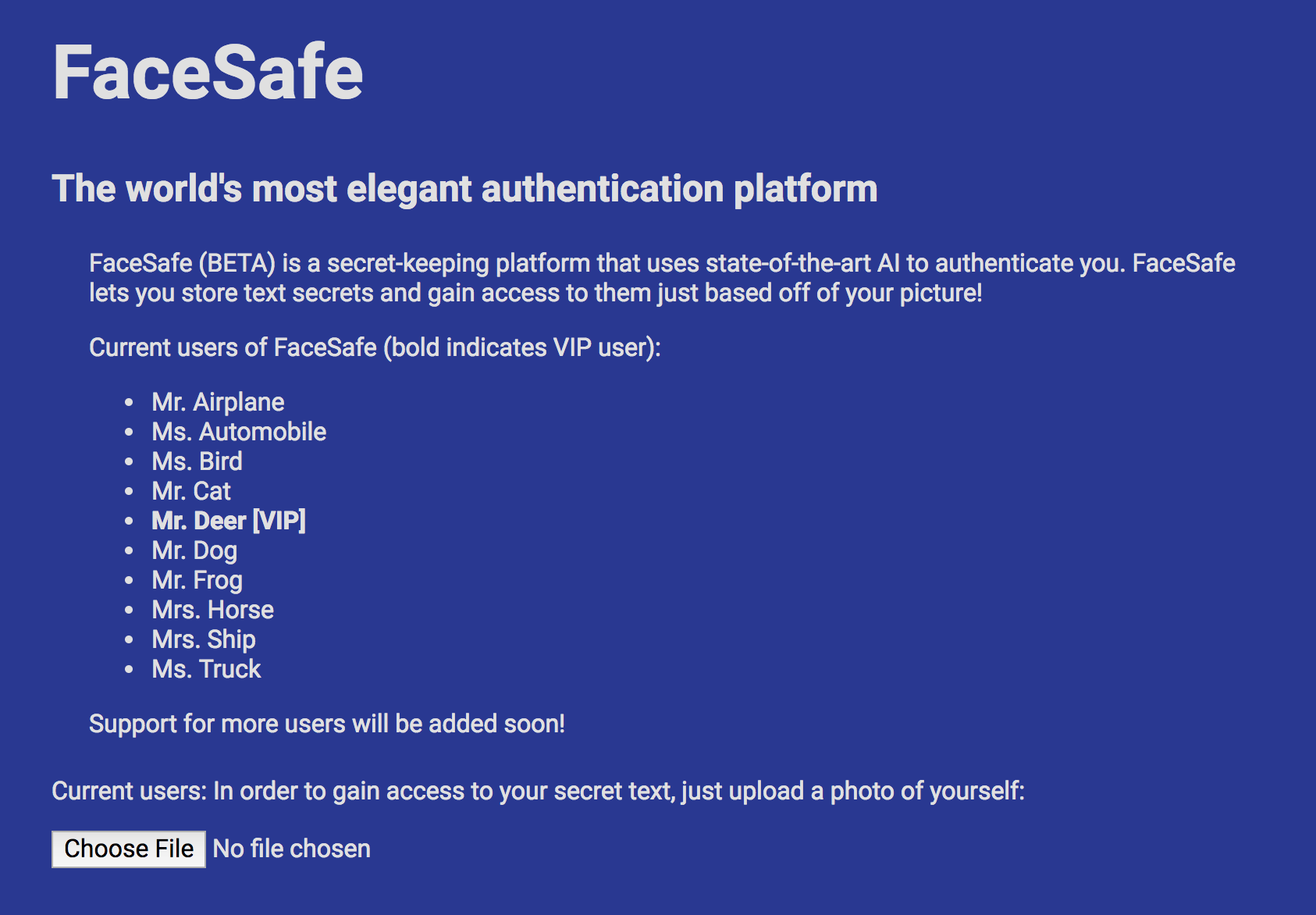UTCTF 2019 - FaceSafe (1400pt)
ML Crafted Input
March 10, 2019
machine learning
FaceSafe (1400pt)
Exploit
Description: Can you get the secret? http://facesafe.xyz
Like any startup nowadays, FaceSafe had to get on the MACHINELEARNING™ train. Also, like any other startup, they may have been too careless about exposing their website metadata…
Hint: MACHINELEARNING™ logic: if it looks like noise, swims like noise, and quacks like noise, then it’s probably… a deer?
Solution:
Navigating to http://facesafe.xyz takes us to this page:

The site allows us to upload a 32x32 pixel image. Then it performs some sort of identification to determine which user we are. Finally, if it determines us to be “Mr. Deer” it will hopefully give us the flag.
Someone else on my team found that the robots.txt contained the following listings:
User-agent: *
Disallow: /api/model/auth
Disallow: /api/model/check
Disallow: /api/model/expose
Disallow: /api/model/infer
Disallow: /api/model/model_metadata.json
Disallow: /api/model/model.model
Disallow: /static/event.png
Disallow: /static/find.png
Disallow: /static/bad.png
So this is clearly a machine learning challenge. We can access /api/model/model.model to download the model. It is the type of saved model generated by Keras (a common python ML frontend).
Once we have it downloaded, we can load it:
from keras.models import load_model
m = load_model('./model.model')
Then we can view the structure:
m.summary()
_________________________________________________________________
Layer (type) Output Shape Param #
=================================================================
conv2d_1 (Conv2D) (None, 32, 32, 32) 896
_________________________________________________________________
activation_1 (Activation) (None, 32, 32, 32) 0
_________________________________________________________________
conv2d_2 (Conv2D) (None, 30, 30, 32) 9248
_________________________________________________________________
activation_2 (Activation) (None, 30, 30, 32) 0
_________________________________________________________________
max_pooling2d_1 (MaxPooling2 (None, 15, 15, 32) 0
_________________________________________________________________
conv2d_3 (Conv2D) (None, 15, 15, 64) 18496
_________________________________________________________________
activation_3 (Activation) (None, 15, 15, 64) 0
_________________________________________________________________
conv2d_4 (Conv2D) (None, 13, 13, 64) 36928
_________________________________________________________________
activation_4 (Activation) (None, 13, 13, 64) 0
_________________________________________________________________
max_pooling2d_2 (MaxPooling2 (None, 6, 6, 64) 0
_________________________________________________________________
flatten_1 (Flatten) (None, 2304) 0
_________________________________________________________________
dense_1 (Dense) (None, 512) 1180160
_________________________________________________________________
activation_5 (Activation) (None, 512) 0
_________________________________________________________________
dense_2 (Dense) (None, 10) 5130
_________________________________________________________________
predictions (Activation) (None, 10) 0
=================================================================
Total params: 1,250,858
Trainable params: 1,250,858
Non-trainable params: 0
_________________________________________________________________
So we have several convolution/maxpooling layers followed by a two fully connected (dense) layers. Presumably the final layer is a softmax output that generates probabilites of image classes.
(I’m not going to explain the actual model much more, this is a very common example of a deep convolutional neural network for image classification. Googling any of those terms will lead you to more in-depth resources)
Our goal is to generate an crafted input for this network such that it predicts index 4 with a high probability (corresponding to Mr. Deer).
I adapted the technique presented here to generate this crafted example.
The generation script essentially starts with a random vector. We define the cost as the probability of predicting class 4. Then we take the gradient of the cost and add it to our original vector such that the next time we run the image through the network, it is more likely to pick 4.
This is kind of like standard gradient descent training on a network instead this time, our network weights are fixed and we are updating the image itself.
After letting the following script run for a few minutes, we obtain an image that can fool the network:

# intially random vector
crafted_input = np.random.rand(1,32,32,3)
# learning rate
lr = 0.2
m_in = m.layers[0].input
m_out = m.layers[-1].output
# probability of predicting class 4
cost = m_out[0,4]
# calculate the gradient through our model
grad = K.gradients(cost, m_in)[0]
# function to calculate current cost and gradient
step = K.function([m_in, K.learning_phase()], [cost, grad])
# current prediction
p = 0.0
i = 0
while p < 0.50:
i += 1
p, gradients = step([crafted_input, 0])
crafted_input += gradients * lr
if i % 1000 == 0:
print(p)
print('done!')